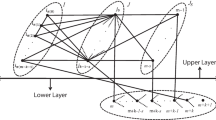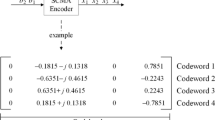Abstract
In this paper, we propose a new construction of signature waveform sets based on Generalized Loosely Synchronization (GLS) sets and different chip waveforms. The new signature sets are applied into the multi-rate multi-cell quasi-synchronous CDMA (QS-CDMA) system where each cell is assigned with a GLS set; different users in the same cell are assigned with different GLS sequences in the same GLS set; user’s different streams are assigned with the same GLS sequence but different chip waveforms. According to the properties of GLS sets, the inter-cell interference (ICI) and the multi-user interference (MUI) in the same cell can be reduced significantly. The interferences among different streams of the same user are handled by an optimal (or suboptimal) multi-stream detector(s), notice that the multi-stream detector mentioned here is also named as multi-user detector in other references. We compare the performance of the multi-rate multi-cell QS-CDMA system employing the proposed sets with that of multi-rate system employing well-known concatenated orthogonal/PN sets and that of single-rate system employing GLS sets. The results show that the multi-rate system employing the proposed sets can achieve significant interference reduction. Meanwhile the performance of multi-rate system is similar to that of single-rate system due to the inclusion of multi-user detection.
Similar content being viewed by others
References
Pursley M.B. (1977) Performance evaluation for phase-coded spread-spectrum multiple-access communication-part I: system analysis. IEEE Transaction Communication, COM- 25(8): 795–799
Pursley M.B., Sarwate D.V. (1977) Performance evaluation for phase-coded spread-spectrum multiple-access communication-part II: code sequence analysis. IEEE Transaction Communication, COM- 25(8): 800–803
Tang X.H., Mow W.H. (2006) Design of spreading codes for quasi-synchronous cdma with intercell interference. IEEE Journal of Selected Areas Commmunication, 24(1): 84–93
Fan P.Z., Hao L. (2000) Generalized orthogonal sequences and their applications in synchronous CDMA systems. IEICE Transactions on Fundamentals E83-A(11): 1–16
Fong M.H., Bhargava V.K., Wang Q. (1996) Concatenated orthogonal/PN spreading sequences and their application to cellular DS-CDMA system with integrated traffic. IEEE Journal of Selected Areas Commmunication, 15(3): 547–558
Amoroso F. (1980) The bandwidth of digital signals. IEEE Communication Magazine, 18: 13–24
Nguyen H.H., Shwedyk E. (2002) Bandwidth constrained signature waveforms and Walsh signal space receivers for synchronous CDMA systems. IEEE Transactions Commununication, 50: 1137–1149
Nguyen, H. H., & Shwedyk, E. (2000). Lower bound on the total squared correlation of the bandwidth constrained, time-limited signal sets. In Proceedings on IEEE International Symposium on Information Theory, Sorrento, Italy, p. 378.
Cheng, R. S., & Verdú, S. (1989). Optimal signal design for band-limited PAM synchronous multiple-access channels. In Proceedings on 23rd Conference Information Sciences and Systems (pp. 321–326). Baltimore, MD, March 1989.
Salmasi, A., & Gilhousen, K. S. (1991). On the system design aspects of code division multiple access(CDMA) applied to digital cellular and personal communications networks. In Proceedings on IEEE VTC (pp. 57–62). May 1991.
Fong, M. H., Wang, Q., & Bhargava, V. K. (1994). Concatenated orthogonal/PN codes for DS-CDMA systems in a multiuser and multipath fading environment. In Proceedings on IEEE Globecom (pp. 1642–1646). November 1994.
Proakis J.G. (1983) Digital communications. McGraw-Hill, New York
Author information
Authors and Affiliations
Corresponding author
Rights and permissions
About this article
Cite this article
Feng, L., Fan, P., Hao, L. et al. A New Construction of Signature Waveforms for Multi-rate Multi-cell QS-CDMA Systems. Wireless Pers Commun 50, 493–507 (2009). https://doi.org/10.1007/s11277-008-9620-0
Received:
Accepted:
Published:
Issue Date:
DOI: https://doi.org/10.1007/s11277-008-9620-0




